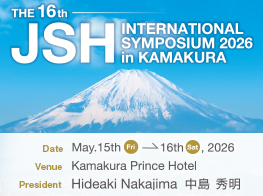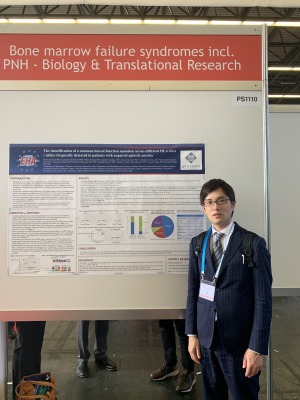名前:水牧 裕希【金沢大学医薬保健研究域医学系 血液内科学】
発表日時:2019年6月15日
発表形式:Poster
Title:
The identification of a common loss-of-function mutation across different HLA class I alleles frequently detected in patients with acquired aplastic anemia
Authors:
Hiroki Mizumaki 1, Kazuyoshi Hosomichi 2, Mikoto Tanabe 1, Takeshi Yoroidaka 1, Tatsuya Imi 1, 3, Kohei Hosokawa 1, Takamasa Katagiri 4, Hiroyuki Takamatsu 1, Tatsuhiko Ozawa 5, Fumihiro Azuma 6, Hiroyuki Kishi 5, Atsushi Tajima 2 and Shinji Nakao 1
Affiliations:
1. Department of Hematology, Kanazawa University, Kanazawa, Japan
2. Department of Bioinformatics and Genomics, Graduate School of Advanced Preventive Medical Sciences, Kanazawa University, Kanazawa, Japan
3. Department of Internal Medicine, Keiju Kanazawa Hospital, Kanazawa, Japan
4. Clinical Laboratory Sciences, Kanazawa University Graduate School, Kanazawa, Japan
5. Department of Immunology, University of Toyama, Toyama, Japan
6. HLA Laboratory, Japanese Red Cross Kanto-Koshinetsu Block Blood Center, Tokyo, Japan
Abstract:
Background: The presence of HLA class I allele-lacking leukocytes due to the copy-number neutral loss of heterozygosity in the short arm of chromosome 6 (6pLOH) or HLA allelic mutations is compelling evidence supporting the notion that cytotoxic-T lymphocyte attack on hematopoietic stem and progenitor cells (HSPCs) underlies the development of acquired aplastic anemia (AA). We previously reported that deep sequencing of HLA class I genes of HLA-class I allele-lacking granulocytes revealed various loss-of-function mutations in alleles such as HLA-B *40:02, A *02:06, and A *31:01, suggesting that limited HLA-class I alleles are involved in the autoantigen presentation of AA (Zaimoku, et al. Blood. 2017; 129: 2908-2916; Mizumaki, et al. Blood. 2018; 132: 2584). Of interest, our previous studies have revealed a common nonsense mutation in exon 1 of the HLA-A and B genes (Exon1 mut) leading to the loss of specific HLA alleles across different class I alleles in AA patients harboring 6pLOH. If the Exon1 mut is frequently detected with a sensitive assay in AA patients regardless of the presence of 6pLOH, it would serve as a useful indicator of the presence of an immune pathophysiology of bone marrow failure.
Aims: To determine the prevalence and clinical significance of Exon1 mut in AA, we established a novel droplet digital polymerase chain reaction (ddPCR) assay for precisely detecting Exon1 mut in the peripheral blood of AA patients and investigated the correlation of the mutated sequence with the response to immunosuppressive therapy (IST).
Methods: Exon 1 regions of HLA-A and HLA-B alleles were amplified using two different sets of primer pairs that are complementary to the consensus sequences of the HLA class I alleles. The amplicons were subjected to a ddPCR assay using TaqMan probes with substituted locked nucleic acid bases complementary to wild-type (WT)and Exon1 mut sequences, which were labeled with different fluorochromes (FAM and HEX). The fractional abundance of the mutant allele was obtained by dividing the number of copies per microliter of the mutant allele (FAM) by the total copies per microliter of the WT allele (HEX) plus the mutant allele (FAM). Peripheral blood leukocytes from 248 patients with AA who were 14-93 years of age 97 with severe AA and 151 with non-severe AA; 115 males and 133 females; 80 6pLOH[+] and 168 6pLOH[-]) were subjected to the ddPCR assay, and the correlation between the presence of Exon1 mut and response to immunosuppressive therapy in newly diagnosed AA patients was examined.
Results: Mixing experiments showed the ddPCR assay was able to detect as few as 0.07% leukocytes with Exon1 mut in the background WT leukocytes. Exon1 mut was detected in 51 (64%) of the 80 6pLOH(+) patients; their lost alleles were A *02:06 (n=11), A *31:01 (n=3), B *40:02 (n=23), B *54:01 (n=6), and other alleles (n=8). Exon1 mut was also detected in 35 (21%) of the 168 6pLOH(-) patients. The median variant allele frequencies of Exon1 mut was 0.59% (range, 0.074% to 8.70%). Overall, 86 (35%) of the 248 patients with or without 6pLOH were positive for Exon1 mut. Fifty Exon1 mut(+) patients were treated with IST (antithymocyte globulin+cyclosporine [CsA], n=30 or CsA alone, n=20), and 43 (86%) showed a response.
Summary/Conclusion: HLA allelic loss due to Exon1 mut is common in AA patients. The presence or absence of this mutated allele can be determined using the ddPCR assay within 8 h without any information about patients’ HLA genotypes. This assay is therefore thought to be a powerful tool for diagnosing an immune pathophysiology of bone marrow failure.
EHA2019参加レポート
この度は,24th Congress of European Hematology Association(EHA)の参加にあたり,日本血液学会EHA Travel Awardに採択していただきありがとうございました。
今年のEHA Congressは,2019年6月14日から17日にかけてオランダ・アムステルダムで開催されました。アムステルダムは運河が張り巡らされ,歴史のある中世の街並みと運河は世界遺産に登録されています。美しい町並みを眺めながら,学会場とホテルを行き来することは毎日の楽しみでした。また,ほとんど起伏がない地形のため,自転車を使用している方が多く,自転車専用レーン,駐輪場が街中に整備されているのが印象的でした。今回の24th EHA Congressのロゴマークには自転車が使われていました。
私自身EHAは初めての参加となりましたが,米国血液学会(ASH)と比べると会場はひとまわりコンパクトで,学会スケジュールは余裕をもって聴講できるよう組まれており,聴講したい一般口演,教育講演を無理なく回ることができました。再生不良性貧血(AA)に関する発表は,ASHに比べると非常に少なかったのですが,King’s CollegeのGhulam Mufti先生,NIHのNeal Young先生の教育講演ではAAのゲノム解析の結果を含めた基礎実験のデータから最新の臨床研究までサマライズされており最新の知見を整理することができました。また,ミュンヘン白血病研究所のTorsten Haferlach先生によるclinical sequenceに関するplenary sessionでの発表が印象的で,DNA抽出から最短で2日でシークエンスデータの結果報告を行うというものでした。近年,新規薬剤が続々と承認されておりNGSでのゲノム解析の結果を用いた個別化医療の重要性を改めて実感いたしました。
私は今回,再生不良性貧血患者のHLAクラスI遺伝子に共通する機能喪失型変異を高感度かつ迅速に検出する方法に関する発表を行いました。再生不良性貧血(AA)は,造血幹細胞(HSC)上の特定のHLAクラスIアレルによって提示される何らかの自己抗原ペプチドを細胞傷害性T細胞(CTL)が認識することによって発症するとされています。一部のAA患者に検出される「HLAクラスIアレル欠失白血球(HLA-LL)」の存在は,CTLによるHSCの攻撃によってAAが発症する最も直接的な証拠と考えられています。我々は,以前HLA-LLを有するAA患者のHLAクラスI遺伝子を次世代シーケンサーで詳細に解析し,A *02:06,B *40:02,B *54:01などの限られたHLAクラスIアレルに機能喪失型変異が検出されること,HLAクラスIアレルのexon 1領域に異なるHLA間で共通するナンセンス変異がしばしば検出されることを明らかにしました。そして,今回この共通変異を高感度かつ迅速に検出するためのdroplet digital PCR(ddPCR)アッセイを新たに確立することに成功し,約30%ものAA患者にこの共通変異を検出することができました。また,AAの免疫病態マーカーであるPNH型血球の陰性例においても1/4の症例に共通変異を検出しました。このddPCRアッセイの最大の利点は,患者のHLA型が分からなくても,HLA欠失血球があるかどうかを迅速に判定できることにあります。今後,再生不良性貧血をはじめとした免疫病態による骨髄不全症の診断に非常に有用な新規診断ツールとなり得ると考えられます。
末筆となりますが,今回このような素晴らしい機会をいただき,日本血液学会事務局の皆様,国際委員会の先生方,そして直接研究のご指導をいただいています中尾眞二先生に心から感謝いたします。





